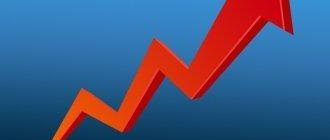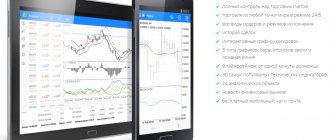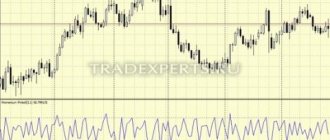In order for trading on the stock exchange to be successful, you must have a sufficient amount of knowledge. This will avoid stupid mistakes and minimize the risks of losing money.
In fact, we are not talking about attending specialized educational institutions and obtaining a diploma in the field of economics and finance. To get started, it is enough to understand the topic well and form an objective idea of the stock market and what is needed for trading.
We invite you to familiarize yourself with the basic concepts that are vital for novice traders.
What is trading
Earning money by speculating in various types of assets on financial and commodity exchanges is called trading.
Assets are currencies (rubles, dollars, pounds sterling), securities (stocks, bonds, derivatives), goods (oil, gold, grain crops, etc.).
Before becoming a trader and starting independent trading, you need to master the theory of the profession and gain initial practical skills.
"The Intelligent Investor" Benjamin Graham
Although the book was written back in 1949, it has not lost its significance. The author was the first to point out the importance of proper investment. Now his ideas are used by a large number of people.
This work is considered the “Bible of the stock market.” Here you can find information about passive and active income and investment strategies. With concrete examples, it is very easy for even beginners to understand security analysis.
To date, the book has not lost its significance, although more than 70 years have passed and humanity has noticeably stepped forward. At the end of each chapter in the modern version, you will see a detailed commentary from the famous investment columnist Jason Zweig.
Buy a book on liters →
Types of trading
Trading on exchange platforms is carried out in different forms, which differ:
- duration of transactions;
- ways to analyze the market situation;
- trading signals and patterns;
- technical indicators;
- methods for determining entry and exit points from a position;
- number of tools;
- risk calculation methods;
- using trading robots, etc.
Every professional speculator has a strict system according to which he carries out his transactions.
Scalping
Trading strategies that are designed for small time intervals - timeframes - are called scalping. A scalper makes from several to hundreds of transactions in 1 session - a trading day.
The trader enters the market based on trading signals that are formed on the chart or in the tape (book of exchange) in the form of indicator readings, graphic patterns, and volumes of traded contracts.
The scalper's TS determines the number of traded lots, the moment of exit from the transaction, the order of setting and the size of the stop loss - from several points.
Trading in the medium term
If a speculator holds open positions for several days or weeks, this is a medium-term strategy. Trends that have existed in the market for a relatively long time are monitored.
Traders are forced to set “stops” of 30-40 points, which requires more capital in reserve.
This trading system does not require constant presence at the monitor. On different timeframes, signals for entering the market are often similar in structure.
Both a scalper and a medium-term trader can use channels, trend lines, resistance and support levels, and the same indicators.
Long-term trading
Long-term strategies have the following advantages:
- do not require quick decisions, because trends last for months and years;
- commissions and fees are relatively small (for example, spread when concluding a transaction);
- no need to monitor the chart or feed every day (let alone every second);
- it is possible to receive dividends on shares;
- there are tax benefits;
- there is no daily stress waiting for results.
Example - paperclip strategy:
But they have a number of disadvantages:
- the investor does not immediately learn about the erroneous calculation;
- long periods of market pullbacks;
- short-term and medium-term trends are skipped without profit.
Moment
Traders who adhere to such a system enter the market at any opportune moment. They monitor all time frames and orders are placed where there is a signal.
The strategy can be considered comprehensive. Rarely used. But on our website there is a large number of such strategies and the most striking example is the graphic strategy of the BF2 website and an example of trading on it - FREE signals for every day ⇒:
Fundamental
The basis for decision-making by a speculator are fundamental indicators:
company profit;- cash flow status;
- obligations;
- quality of management;
- political situation.
The disadvantages of such strategies are:
- data inaccuracy;
- overestimation of indicators;
- unexpected events with low probability - “black swans”;
- influence of crowd psychology on price.
Technical
A specialist uses graphs and diagrams of changes in the value of an instrument to study the market. Trading can be considered technical when data obtained from such analysis is used to enter the market and close a position.
Using a mathematical apparatus, technical indicators and robotic programs are created that are capable of opening and closing transactions according to a given algorithm (semi-automatically or automatically).
Graphic patterns - “head and shoulders”, “triangle”, etc. are also figures of technical analysis.
Swing trading
Most often, a position in swing trading is held from several hours to 2-3 days. Swing trading is the use of changes (fluctuations - from swing) in the price of an asset to make a profit.
The basic principles of this strategy:
- correct entry - at the end of a rollback along a trend or on news, characterized by immediate movement of the chart in the desired direction;
- it is necessary to withstand short-term corrections;
- strict procedure for closing unprofitable transactions.
Larry Williams "Long-Term Secrets of Short-Term Trading"
Next in our selection is a unique approach to understanding the market from the legend of trading - Larry Williams.
What's interesting about this book:
- mentioning non-obvious statistics (for example, that the chances of a bull day after two bear ones exceed 50%, in contrast to the opposite situation);
- an attempt to explain how to look for reversals and the end of a pullback on bar charts;
- other statistical patterns on various types of futures.
I remember the first item from the above list the most; it really interested me. At that time, I already knew how to test strategies well and tested these conclusions in practice, and they turned out to be true. The rest of the book didn't seem that interesting to me.
How to trade and engage in trading via the Internet, 7 stages of trading - where to start for a beginner
Stage-1: Search for a broker/dealing center
Transactions on the stock exchange are concluded through intermediaries - brokers, and in the Forex currency market - brokerage companies and dealing centers.
When choosing a company to work in the markets, you need to pay attention to the following characteristics:
- Quality of customer information support. Possibility of free training in trading from scratch, availability of seminars, courses, materials. Providing analytical reviews, news, investment consultants.
- Brokerage commission amounts.
- Presented trading terminals.
- Quality of data stream - absence of requotes, packet losses, etc.
- Types of trading accounts.
- Tools that are available for the job.
Stage-2: Opening an account, replenishing a deposit
To buy and sell through an exchange, you must have a trading account with one or more brokerage firms.
The procedure for opening a brokerage account, the minimum deposit and the list of required documents may vary depending on the company.
You need to keep in mind that in order to withdraw earned funds, the intermediary will require scans of your passport, even if they are not needed for the initial replenishment.
Stage-3: Start of opening positions
To make transactions, you will need to select an instrument - currency, shares, goods and buy or sell it. The minimum amount of an asset - lot, available for a transaction depends on the exchange and dealer.
Stage-4: Installation of trading programs
The main program in which the trader works is the terminal. They differ for different platforms and brokers.
Russian intermediaries most often use QUIK to work on the derivatives and commodity markets, and MetaTrader 4 or 5 for Forex.
Stage-5: Quote Analysis
To monitor changes in the price of an instrument, there are 2 main ways:
- studying the chart in the trading program;
- analysis of the market order book (market depth, price tables, tapes).
The developers offer hundreds of technical indicators that represent price movement in different forms.
Stage-6: Opening trading positions
Traders use the following main types of orders:
- Market - they are executed at the price available at the time the order is opened.
- Deferred - triggered when the value of the asset reaches the desired level.
Pending orders are:
- limit;
- stop (stop);
- stop-limit (stop/limit).
Step-7: Recording profit or loss
Taking Profit - taking profit when the price reaches the expected values or a specified amount of profit appears. You can close a deal manually or automatically.
To limit risk, it is customary to record losses if the market moves against the speculator. For this purpose, a Stop Loss level is set, upon crossing which the transaction will be closed.
In a good trading system, the amount of profit is greater than the amount of losses.
“Security Analysis” Benjamin Graham, David Dodd
The book is a bestseller in modern trading, although it was written in the middle of the last century. This is a guide to the basics of security analysis. It covers not only the basics, but also describes in detail the analysis of financial statements, stocks, and bonds.
The book has several goals: to teach readers to correctly analyze stocks and securities so that their owner can make a profit. And also find out which assets are safe to purchase at the current expected price. This is one of the world famous books that allows you to understand the “Graham phenomenon”.
Choosing a Forex broker – top 3 brokerage companies
The best service on the Russian market is provided by the leaders among brokers.
To attract customers, smaller companies can offer better conditions for certain items (minimum deposit, bonus for replenishing an account, etc.). But in the complex - reliability, availability of trained specialists, number of services - leading companies will be the best choice.
Alpari
The company has existed for more than 20 years. Its services are used by about 2 million clients.
To make transactions on the Forex market, MT4, MT5 terminals and mobile applications are provided.
Investors can earn money on the foreign exchange market using PAMM accounts ⇒ .
The company provides speculators with analytics and daily market reviews. Those who wish can trade using signals from experienced traders.
Detailed information with real customer reviews - HERE ⇒
Forex4you
The company trades 150 instruments, including currencies, indices, oil, metals, cryptocurrencies, and shares of leading companies.
The broker offers 4 platforms:
- Forex4you Desktop;
- Forex4you Mobile;
- Forex4you WebTrader;
- MetaTrader 4.
The company is the leader of the trading social network Share4you.
Read more about the company + reviews from real clients of the site HERE ⇒
Roboforex
The broker guarantees the highest speed of order execution and minimum spreads - for some accounts up to 0.
You can open accounts in 6 currencies - USD, EUR, RUB, BTC, ETH, GOLD. The minimum replenishment amount is 10 euros or dollars. The maximum leverage is 1:2000. It is possible to withdraw funds without commission.
Bonuses are provided for clients - for replenishment up to 115%, cashback, profit share, CopyFx.
Similar to other companies, see reviews of this broker HERE ⇒
“Turtle Traders” Michael Covel
A very interesting and useful book, as it describes a large experiment.
Experienced Chicago trader Richard Dennis once argued with colleague William Eckhardt about whether anyone could be taught this profession. For the experiment, Denis invited people through an advertisement in the newspaper to a 2-week course. 23 people were accepted. They became “turtle traders” who brought Denis a profit of $100 million.
The book describes all the details of training people, by what rules they entered and exited the market. Here you will see personal advice from Eckhardt and Denis, biographies of all the people and trading philosophy.
Types of programs, applications, services for online trading
Many IT tools have been developed to carry out online trading activities, some of which are provided by brokers free of charge.
Software for Beginners
Beginning speculators need programs that facilitate rapid learning.
One such product is Forex Tester. Using this IT tool, it is easy to test new strategies on history or in real time without risk, to see how indicators or trading robots behave in a particular market.
It is on such a tester that we test all the strategies of this site and here they are ALL - the results of testing trading systems ⇒
Applications for beginners have built-in services for learning the principles of the exchange, terminology, and demonstrating transactions of experienced specialists.
For professionals
A professional trading program performs the following functions:
- provides access to transactions with different instruments;
- organizes and displays collected data;
- implements elements of technical market analysis.
Such applications include trading and analytical programs: ATAS, Quik, MetaTrader 4/5, which are capable of making an in-depth analysis of the situation for the selected instrument and providing information to the user in an intuitive way.
For automated trading
With the development of computer technology, software has appeared that can work without human intervention - trading robots for automatic trading.
First of all, we recommend the Crazy Lock advisor ⇒
And the second one - 10 pips + martingail ⇒
Advantages of automatic IT tools:
- absence of an emotional component that interferes with market analysis;
- the ability to trade around the clock;
- the operation is performed at high speed.
But such programs are not capable of analyzing fundamental data; their work is affected by viruses and electronic failures.
John J. Murphy "Technical Analysis of Financial Markets"
It’s not for nothing that they say that “repetition is the mother of learning.” I met John Murphy after having studied technical analysis extensively in other sources. However, this book allowed me to look at all the axioms of trading from a different angle.
Distinctive features of this work:
- there are references to the history of technical analysis, namely to Charles Dow’s theory of trends, which helps to understand where this method came from and why it became so;
- describes aggressive and conservative trading of rollbacks (at 30% and 50% of the movement), which Schwager does not have;
- the rest concerns figures and other technical tools. analysis.
I definitely recommend this book as another textbook for learning charts. It significantly complements what I mentioned above.
Social trading - social trading and copy trading
There are social networks that are created specifically for traders and have built-in functionality for carrying out transactions and exchanging among themselves:
- signals for entering the market;
- graphs;
- performance results.
Repeating trades of leading traders can greatly increase trading profitability.
How social trading works
Social trading first appeared in Russia, 1 month ahead of a similar project in the USA.
The threshold for connecting to a system that has access to the market is 50 thousand rubles. and higher. Such requirements are explained by the need for affiliated participants to automatically repeat all transactions of the strategy author with exchange instruments.
For example, the comon.ru service has 470 trading systems from which an investor can choose. Metaquotes also has a similar one - a built-in service from Metatrader.
Top 3 best platforms
Platforms differ in the quality of signals for entering the market and closing orders, the number of participants, and the security of funds placed in the system.
Share4you service from Forex4you
The Forex4yu company offers its service for copying transactions, which has proven itself for several years.
The service is ideal for beginners, as it allows you to copy transactions of successful traders, whom you can select on the website and connect specifically to their accounts.
There is no need to worry that a trader will steal your money, because it is always in your account and you decide when to stop copying if it does not bring you profit!
CopyFX service from Roboforex
The Roboforex group of companies offers the CopyFX investment platform for copying transactions.
Advantages of the system:
- minimum entry threshold - from $100;
- there is no need to delve into the intricacies of trading and constantly be “in the market”;
- for a trader - the opportunity to receive additional income by copying his strategy.
The disadvantage is common to all exchange trading - the possibility of losing funds, because... CFDs are complex, high-risk instruments with high leverage.
Independent platform Zulutrade
The platform allows you to make 3 types of transactions:
- independently determining entry points;
- automatically copy experienced traders;
- combined approach.
A trader can:
- create a list of signal providers;
- change the lot size;
- determine volumes for currency pairs;
- stop work for the selected period.
“One Good Trade” Mike Bellafiore
The book was included in the top of the best trading manuals for beginners. The author, based on his experience, describes the qualities that a beginner should have, mistakes and important lessons. The author's experience is 12 years of work in private trading.
The work is very easy to understand - it is written not in complicated phrases, but in understandable words. Gives a lot of useful information that will be useful both when learning to trade and when making real money.
Buy a book on liters →
You can learn not only from books. There is an excellent selection of 20+ best online courses for beginners and professionals that will help you learn trading much better.
As well as an additional service, I would like to introduce a service from Instaforex - ForexCopy
I won’t tell you for a long time, just watch the video below, but here’s a clear diagram of how the service works:
- The service has monitoring of traders, which you can select personally, having previously sorted them according to the parameter you personally need.
- Simple registration - just open an account, top up, choose whose transactions to copy and that's it.
- TOP traders are highlighted.
- Answers to frequently asked questions.
- Excellent support on the broker's website.
And the promised video:
Pros and cons of social trading
By participating in social networks, a trader:
- gets the opportunity to consult and discuss the market situation;
- uses the developments and templates of other participants;
- has access to the knowledge of more experienced traders;
- earns additional money for others using his strategy.
Disadvantages of social trading:
- The need to pay for access to the vehicle.
- Possibility of distortion of information about the results of the proposed system.
- Software glitches and errors cannot be ruled out.
- Sudden changes in the market situation can make any strategy unprofitable.
“Stock Secrets” Lawrence Connors, Linda Raschke
The authors wrote the book based on their own experience of trading on stock exchanges. You will see their trial and error. There is a model of behavior here that allows you to earn maximum profit with minimal risk.
The book is designed for people who have been trading for several days. It describes trading strategies that take the trader to a new financial level. The rules for managing your capital are clearly and clearly formulated and described. Helpful tips will help stock and futures traders work on their own trading method, especially in short time frames.
Learning the basics of trading - 3 ways
The only criterion by which one can judge a trader’s knowledge and skills is the state of his account. Understanding the market comes with time and effort. 3-4% of participants consistently earn money on the exchange, the rest lose money.
To make profitable trades, you need to learn to understand the logic behind asset price movements.
There is no universal “Grail” formula for safe trading. But a clear understanding of the mechanisms inherent in exchange activity, the psychology of trading, and methods of calculating risks allow a trader to create a system capable of generating income with 70-80% of unprofitable transactions.
1 - Self-study
Learning to trade on your own is a difficult task. There are many books and articles about working on the stock exchange and not all of them are of high quality. In addition, like any profession, trading has its own specific terminology.
It is better to start getting acquainted with the markets on popular resources, EXAMPLE - this site, which remains the best in terms of training and profitable strategies for trading, which monitors users' opinions about themselves, carefully selects publications.
The acquired knowledge can be tested by making transactions on selected platforms with little money or using demo accounts - educational virtual trading.
2 - Online training
Brokerage companies offer their clients educational materials and courses.
Online training is provided by some successful traders and forex companies who hire them as teachers.
A lot of information can be found on various resources on the Internet, both paid and free content ⇒ (this is a list of our best training courses on the site)
Here is an example of some of them:
- Training SF Start Up 2.0 ⇒
- Safe Forex 2 ⇒
The most popular are webinars, where the student has the opportunity to communicate with the teacher and ask him questions to better understand the material covered.
3 — Attending face-to-face classes
In large cities, you can study face-to-face in individual or group classes. Schools, courses, and seminars are most often organized by dealing centers and brokers.
Professional traders are involved in the training process, who conduct training trades on exchange platforms with assets and money.
After completing the training courses, you can take the international LEVEL 1 and CFA exams for a fee, which will confirm the applicant’s skills and knowledge in the field of investment and financial analysis.
Who is a trader
There can be no doubt that many do not fully understand this term. Most believe that this is a person who trades valuable assets on international exchanges. In part, this is true.
But we should not forget that a trader is, first of all, an expert in the world of finance. This is at the same time:
- an entrepreneur who invests in his future;
- an analyst who can foresee the development of the international economy;
- a strategist who thinks through moves many steps ahead.
All these areas of activity require completely different skills and abilities. Therefore, traders are very versatile and educated individuals. In addition to opening orders, they perform a huge amount of work.
Trading for beginners will take from 3-4 hours to a full working day. The more you are willing to work, the faster the first results will appear. The profession is difficult and requires dedication.
If you are counting on quick money, then this is not what you need. Don't waste time starting something that you will later quit. On the other hand, good traders are always financially successful and can afford a lot.
How to complete training for beginners - step-by-step instructions and what you need to know
To increase your finances using the market, you will have to study different topics in the profession:
- Basics of the functioning of the exchange.
- Types of trading instruments.
- Market infrastructure.
- Fundamental and technical analysis.
- The mechanism for forming the value of assets.
- Management of risks.
- Macroeconomic statistics.
- Charts - tick, line, candlestick, bars.
- Support and resistance levels.
- Fibonacci numbers and Elliott wave theory.
- Graphic models, indicators, etc.
Choosing a learning method
The method of training is chosen depending on the place of residence and financial capabilities.
You can start getting acquainted with the basics of trading at your chosen brokerage firm. It is better to decide in advance on your preferred trading instruments, which will allow you to concentrate on their features from the beginning of your studies. Each market - currencies, futures contracts or securities - has its own specifics.
Mastering the market and main concepts
Knowledge of financial terminology is the basis for understanding.
You need to familiarize yourself with the basic concepts of the profession:
- order;
- leverage;
- spread;
- trend, etc.
You will need to master trend reversal and continuation models, patterns and figures - “wedge”, “flag”, “rectangle”.
Most trading systems use indicators - trend indicators or oscillators. It is necessary to understand the principles of their operation and the signals they give.
Studying the trading terminal
Trading for dummies begins with studying the terminal. To understand the functionality of the program, you can work on a demo account for some time. In this case, the trading participant sees asset charts in the current time, but enters into trades in a training demo mode.
Basic skills for working in trading programs:
- selection and adjustment of the instrument chart;
- connecting indicators;
- methods of opening and closing orders;
- use of Take Profit and Stop Loss.
Learning the basics, risk management
Risk management is the basis for the profitability of exchange activities. A trader must limit losses if the market turns against him. A profitable trading system takes into account how much it is permissible to lose in one transaction in order to remain in “profit” at the end of the day, week or month.
Risk management recommends:
- do not stay at the monitor for a long time;
- keep records of transactions and mistakes made;
- set stop losses upon entry;
- when opening a position, the ratio of profit to loss should be 2:1 or 3:1;
- do not invest more than 1-5% of the deposit in 1 transaction.
Learning the basics of fundamental analysis
Price movements are determined by fundamental political and economic factors - indicators of the state of affairs in the national economy or company.
The most important events are reflected in the economic calendar. It also contains information about the decisions of the IMF, Central Banks, statistics on unemployment, oil reserves, etc.
The publication of news causes market fluctuations and provides speculators with the opportunity to profit from changes in asset prices.
Technical market analysis
The technical analysis is based on the following basic principles:
- The price takes everything into account.
- Prices follow the trend.
- History repeats itself.
Tools used by traders and analysts:
- trend lines;
- patterns;
- indicators;
- levels - support, resistance, correction.
Opening a demo account and practicing
By registering with one of the Brokerage firms ⇒ , you can download the terminal and open a demo account.
Depending on the characteristics of the dealer, the list of instruments available for trading may vary.
A training account is needed to:
- learn to use the program;
- gain skills in placing orders;
- configure indicators;
- test the strategy;
- learn to see patterns, for example “SPIRE”, etc.:
“How to Make Money in the Stock Market” William J. O'Neil
The book is very popular as it provides useful knowledge in simple language. It can be downloaded or read online for free. It was written by a well-known stock trader who used the CAN SLIM stock selection method. Now the author is a sought-after stock consultant in America.
The system invented by the author still works today. It is based on an analysis of price movements. All the tips in the book apply not only to stock trading, but also to Forex players. You will also find information on technical analysis, where the author teaches how to “read the market” using charts.
Top 5 tips from professionals: how to achieve success in online trading
To minimize errors and take control of emotions, traders use clearly positioned trading systems that allow them to bring actions to automation, analyze errors and correct them.
There are the following main types of vehicles:
- Trending.
- For a breakout of a level or a rebound from it.
- For working in a channel.
Based on the degree of human participation, mechanical, semi-automatic and automatic trading systems are distinguished.
Establish strict discipline
The first thing a stock player should learn is discipline.
Greed, fear, hope, regret are bad advisors. Ludomania (addiction to gambling) and tilt (violation of logic when making losses) can reset your account.
A speculator must be able to:
- enter a deal only when the system signals;
- place a stop order;
- stop working after a series of losses and study the errors.
Limit the trade to the amount you are willing to lose
Depending on the timeframe, you can set your maximum losses for a month, a week, a day, or 1 trade.
For example, if the loss limit for 1 open position is 1% of the deposit, and the acceptable weekly loss is 5%, then 5 negative trades per day should force the trader to stop trading for a week.
Such requirements have been developed by the practice of working on the exchange and serve to prevent the loss of a deposit.
Limit losses on every trade
In the over-the-counter Forex market, the most commonly used leverage is 1:100. Conditions for margin call - forced closing of a position - from 70% of the amount in the account. If you incorrectly calculate the lot size, you can lose almost all your money in 1 trade if the price goes in the opposite direction.
One way to limit losses is the risk formula as a percentage of capital. For conservative trading, it is acceptable to risk 1-2% of the money in the account. Transactions for 4-5% of the deposit are an aggressive high-risk strategy. To simplify the calculation, you can use the MM calculator for MT4 ⇒
Learn from your own experience
Most professional speculators recommend that beginners keep records from their first days on the market.
Accounting for transactions is needed primarily to work on mistakes and improve your trading system. The accumulated statistics will help you see what you need to pay attention to when preparing and executing a transaction.
The lack of documented feedback makes work on the exchange unstable.
Learn to wait
A trader must enter the market and close positions only according to the rules of the trading system.
Most of the time it waits for suitable conditions:
- trend, channel formation, level breakdown;
- moment to enter;
- signal to exit the deal.
You should learn to calmly stay outside the market (“in the cache”) if there are no necessary conditions for work.
If the trading direction is chosen correctly, the price still rarely moves without pullbacks. A novice speculator, afraid of a possible trend reversal, unable to wait, tries to quickly take a small profit and, as a result, loses money.
“A Day Trading Primer” by Lewis Borsellino
This work is suitable for mid-level traders who know what trading training is about. It is narrowly focused, as it considers how to make trades so as not to carry them over to the next day.
Here you will learn when it is best to enter into a deal, exit it, and begin to put into practice methods for finding partners. An important point that the author emphasizes is the trader’s discipline and the practice of technical analysis. A pleasant bonus for you will be the author’s stories about how he managed to achieve success in trading on the stock exchange.
Top 3 books for beginners
Many books have been written on the topic of stock trading, some of them are considered classics. Beginners should familiarize themselves with them first.
Alexander Elder – “Trading with Dr. Elder. Encyclopedia of stock trading"
Experienced trader A. Elder talks about the basics of stock trading in an accessible manner and illustrates the theory with examples of real transactions.
The author explains in detail how to properly manage risks, choose the right asset, and create your own trading system.
Elder suggests:
- several trading strategies of our own have been published on this site, here is an example of one of them and the video below;
- ways to forecast trends;
- methods of psychological analysis;
- methods of maintaining discipline.
Viktor Ilyin and Valery Titov - “The Exchange at your Fingertips”
Experts on the Russian stock market outline the history of its formation, describe investment risks, elements of the exchange infrastructure, and principles of trading stocks and bonds.
The authors write in detail about:
- fundamental analysis and macroeconomic indicators;
- basics of technical analysis;
- choosing a site and broker;
- margin lending;
- features of the Forex market;
- taxation.
There is a dictionary of stock exchange slang and popular recommendations for beginners. The book will help you learn how to become a trader in Russia from scratch.
John J. Murphy - Technical Analysis of Financial Markets
The manual, which is often called the “bible of technical analysis,” contains a lot of theory, example charts and accompanying explanations.
The author covers the following topics:
- tactics and strategies for working on the stock exchange;
- market indices;
- time cycles;
- price movement models (patterns);
- trends and graphs;
- techniques of technical analysis.
D. D. Murphy focuses on the issues of trade volume and open interest, which are presented differently in various types of charts. For the stock market, the number of assets is conveniently displayed, for example, in bar charts, which are not available in Forex.
The author describes in detail the forms of trends and issues of transition from one type of price movement to another - main, intermediate and short-term, or small.
Murphy points out the major trend reversal and continuation patterns that appear on futures and equity charts. The book will be useful both for those who are interested in how to become a trader from scratch, and for experienced speculators.
Jack Schwager "Technical Analysis. Full course"
Now let's talk about a more practically applicable book with a lot of graphs. A beginner should definitely study technical analysis, and there is no better teacher than the classic - Jack Schwager.
What's good about this book:
- there is a description of all current models and figures in those. analysis;
- popular indicators (moving averages, oscillators) are discussed in detail;
- real examples of analysis and possible transactions are shown;
- unique studies of the performance of candlestick patterns are provided (all of them are almost completely useless);
- Several trading strategies are described, but beginners will need time to understand them;
- at the end there is a selection of quotes and recommendations for a trader (very valuable advice, for example, that classical technical analysis works worse on small time frames and it is better to focus on the long term).
At one time I spent almost 2,000 rubles on this book. in a bookstore. I don’t regret the purchase one bit to this day.
Bernard Baumol "Secrets of economic indicators"
Experienced investors know that the hidden keys to future trends in the economy and investments will be macro indicators - macro statistics have too much influence on the markets. A detailed calculation of each indicator and a description of its impact on changes in financial assets makes the book a full-fledged reference book or textbook for a trader. And even if only American indicators are described there, this is quite enough, because the movement of financial markets is most based on US economic statistics.
“Digital Gold” Nathaniel Popper
This is truly one of the best works about cryptocurrencies. It describes how a small idea about digital money led to a big business on a global scale. The book changes consciousness: an unbacked digital currency becomes a profitable investment for millions.
This describes the belief of enthusiasts in the potential of digital money to become accepted throughout the world. Provides data on cryptocurrency trading mechanisms.
Buy a book on liters →
Inside the Black Box – Rishi K. Narang
This book describes in detail how hedge funds work in the field of quantitative trading. Initially, the book is aimed at investors who are unsure whether to invest their finances in such a “black box”. Despite the apparent irrelevance for a private algorithmic trader, the work provides comprehensive material on how a “correct” trading system should work. In particular, the importance of taking into account transaction costs and risk management is discussed.
David Cohen "Stock Market Psychology: Fear, Greed and Panic"
What is more important on the stock exchange - the psychological factor or technical and theoretical preparation? It's like asking which oar is more important for rowing, the left or the right. Most analysts recognize psychology only in words, but in reality they do not delve into it much. I wonder what they will sing when they are faced with their own greed, fears, information overload, market pressure and other aspects that will force them to leave the exchange under the hooting of more successful rivals?
The book is very helpful in building the right psychological attitude in trading, which will benefit both beginners and experienced ones.
“Intuition Trading” Curtis Face
Who said that stock trading, options and investing are only for people with developed logic? Sensitive people can also make money on financial exchanges. Only the process will be different.
Trader Curtis Face, a famous trader, is confident that intuition is an essential part of financial success. The book describes the principles of trading “by intuition”, the rules of trusting intuition. Here you will find tips on how to train, improve and use it for successful trading.
But here you are also taught when you should completely trust your “sixth sense”, and in which cases this is absolutely forbidden.
Buy a book on liters →
Aswath Damodaran “Investment tales. Debunking myths about win-win stock strategies"
The author is a well-known US expert in the field of investments and corporate finance. The book presents the basic theory and detailed analysis of 13 fundamental investment strategies. Moreover, Damodaran connects theory with the realities of the modern market and exposes the myths associated with them. Each chapter is a separate lesson for the investor, which contains practical recommendations on the use of strategies
George Soros "Alchemy of Finance"
The book by the famous speculator gives an understanding of how to make decisions in difficult “combat” conditions of real trading. Soros shares his own philosophy and view of the market. In his opinion, not only investors and traders influence the market situation, but also the market on them. Digesting 400-odd pages of the book will not be easy, but considering the theory of reflexivity is very useful for both beginners and experienced traders. Soros calls reflection a phenomenon when the market and its participants mutually increase their influence on each other, changing the fundamentals and provoking historical changes in the course of trading.











